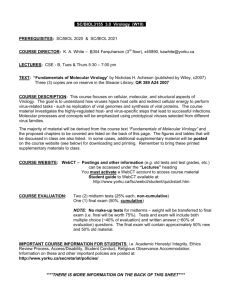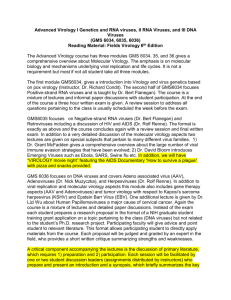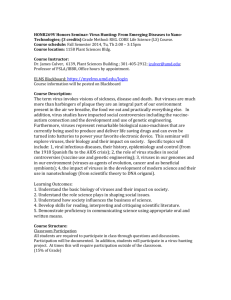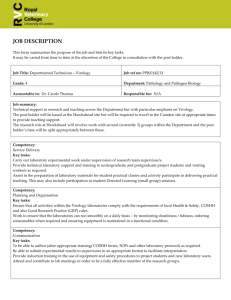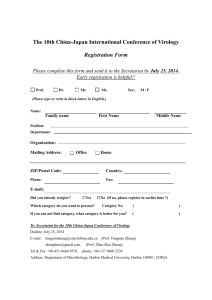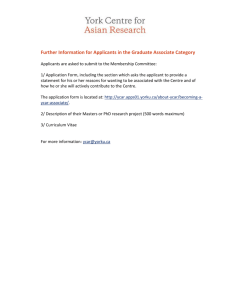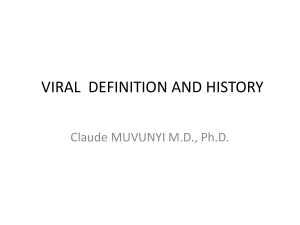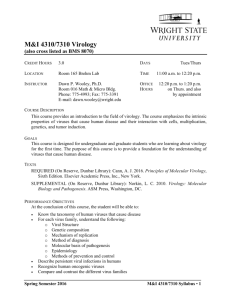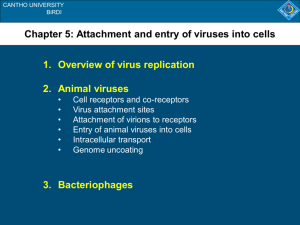SC/BIOL3155 3.0 Virology (W12) ( PRE
advertisement
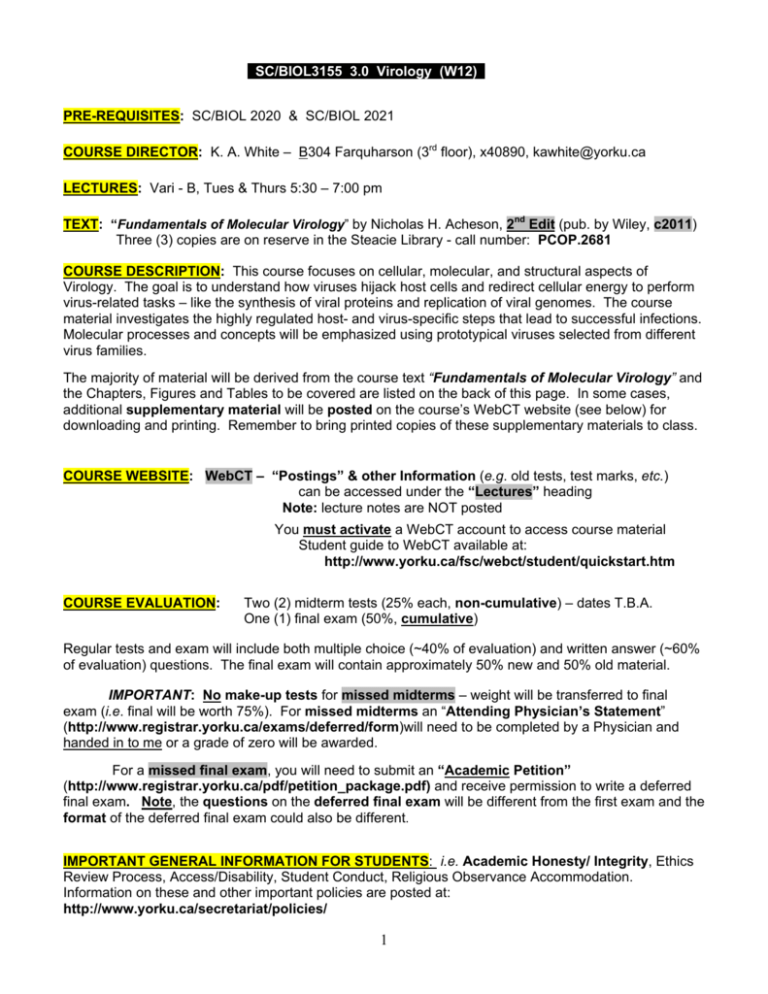
SC/BIOL3155 3.0 Virology (W12) ( PRE-REQUISITES: SC/BIOL 2020 & SC/BIOL 2021 COURSE DIRECTOR: K. A. White – B304 Farquharson (3rd floor), x40890, kawhite@yorku.ca LECTURES: Vari - B, Tues & Thurs 5:30 – 7:00 pm TEXT: “Fundamentals of Molecular Virology” by Nicholas H. Acheson, 2nd Edit (pub. by Wiley, c2011) Three (3) copies are on reserve in the Steacie Library - call number: PCOP.2681 COURSE DESCRIPTION: This course focuses on cellular, molecular, and structural aspects of Virology. The goal is to understand how viruses hijack host cells and redirect cellular energy to perform virus-related tasks – like the synthesis of viral proteins and replication of viral genomes. The course material investigates the highly regulated host- and virus-specific steps that lead to successful infections. Molecular processes and concepts will be emphasized using prototypical viruses selected from different virus families. The majority of material will be derived from the course text “Fundamentals of Molecular Virology” and the Chapters, Figures and Tables to be covered are listed on the back of this page. In some cases, additional supplementary material will be posted on the course’s WebCT website (see below) for downloading and printing. Remember to bring printed copies of these supplementary materials to class. COURSE WEBSITE: WebCT – “Postings” & other Information (e.g. old tests, test marks, etc.) can be accessed under the “Lectures” heading Note: lecture notes are NOT posted You must activate a WebCT account to access course material Student guide to WebCT available at: http://www.yorku.ca/fsc/webct/student/quickstart.htm COURSE EVALUATION: Two (2) midterm tests (25% each, non-cumulative) – dates T.B.A. One (1) final exam (50%, cumulative) Regular tests and exam will include both multiple choice (~40% of evaluation) and written answer (~60% of evaluation) questions. The final exam will contain approximately 50% new and 50% old material. IMPORTANT: No make-up tests for missed midterms – weight will be transferred to final exam (i.e. final will be worth 75%). For missed midterms an “Attending Physician’s Statement” (http://www.registrar.yorku.ca/exams/deferred/form)will need to be completed by a Physician and handed in to me or a grade of zero will be awarded. For a missed final exam, you will need to submit an “Academic Petition” (http://www.registrar.yorku.ca/pdf/petition_package.pdf) and receive permission to write a deferred final exam. Note, the questions on the deferred final exam will be different from the first exam and the format of the deferred final exam could also be different. IMPORTANT GENERAL INFORMATION FOR STUDENTS: i.e. Academic Honesty/ Integrity, Ethics Review Process, Access/Disability, Student Conduct, Religious Observance Accommodation. Information on these and other important policies are posted at: http://www.yorku.ca/secretariat/policies/ 1 SC/BIOL3155 3.0 Virology (W12) ((continued) TEXT: “Fundamentals of Molecular Virology” by Nicholas H. Acheson, 2nd Edit (pub. by Wiley, c2011) Chapters to be covered: Chapter…………..….. Title ………………..…… (Figures / Tables / Postings) Introduction: 1………………… Introduction to Virology … (Figures: 1.1, 1.31.7; Tables: 1.1, 1.2) 2………………... Virus Structure …………… (Figures: 2.1, 2.2, 2.5, 2.9, 2.11, [1.1., 8.3]; Posting: #1) 3………………… Virus Classification………. (Figure: 3.13.3; Tables: 3.13.7) 4………………… Virus Entry………………… (Figures: 4.1, 4.2, 4.4, 4.5, [1.1, 11.3]; Posting: #2) Bacteriophages: 5………………… ssRNA bacteriophages …. (Figures: 5.1, 5.2, 5.45.8; Table: 5.1; Posting: #3) 8………………… Bacteriophage Lambda …. (Figures: 8.18.7, 8.9; Posting: #4) Small DNA Viruses: 22………………. Papillomaviruses …………. (Figures: 22.122.6; Tables: 22.1, 22.2) Larger DNA Viruses: 24…………..….. Herpesviruses …………….. (Figures: 24.124.4, 24.724.9, [4.5]; Tables: 24.124.3) Positive-strand RNA viruses: 12……………… Flaviviruses ………….…… (Figures: 12.212.6, [11.5]; Tables: 12.1, 12.2, Posting #5) 13……………… Togaviruses ………………. (Figures: 13.113.5; Tables: 13.113.3) 14……………… Coronaviruses ….………... (Figures: 14.114.6; Table: 14.1, 14.2) Negative-strand RNA viruses: 18……………… Influenza viruses ……….. (Figures: 18.218.8, [4.5]; Table: 18.1) Retroviruses: 28……………… Retroviruses ………………. (Figures: 28.128.9; Table: 28.1) 29……………… HIV-I ………………………… (Figures: 29.129.7; Table: 29.3) Antiviral agents: 36……………… Antiviral Chemotherapy …… (Figures: 36.136.10, [2.9]) SUCCESS = 1- Read the chapter to be covered before class 2- Attend class and pay attention 3- Review class notes while they are still fresh in your mind 2
